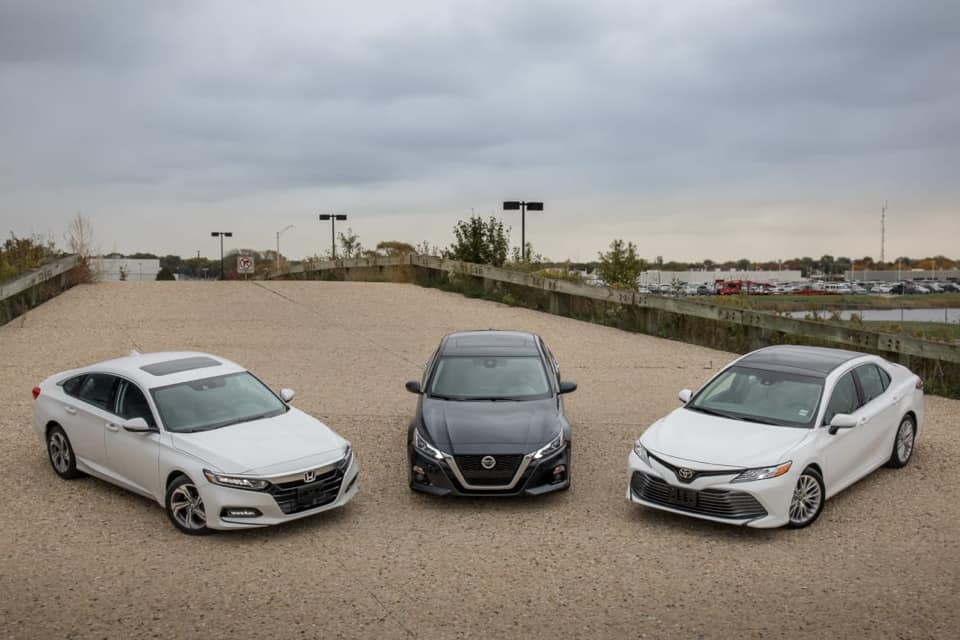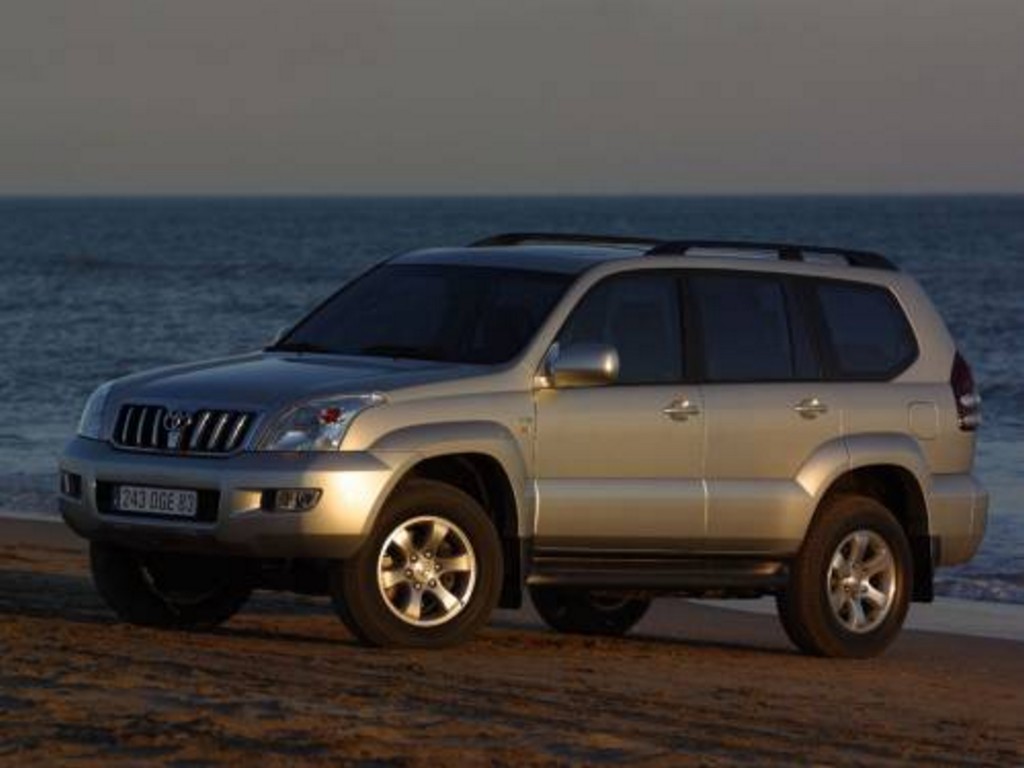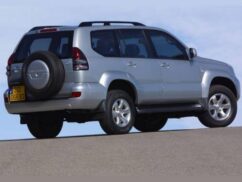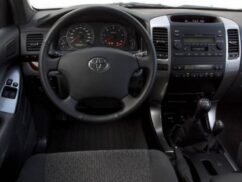2005 Toyota Land Cruiser Prado

| The Good: – Excellent build quality – Large interior – Good offroader |
The Bad: – Slow acceleration – Poor fuel economy – Rearward visibility |
The latest generation of the Toyota Prado is all-in-all a true offroading vehicle, and a strong competitor in the crowded midsize 4WD field. Granted, most desert dwellers choose the Prado’s bigger Land Cruiser cousin, relegating the Prado to mall-hopping duties. But if anyone is after a Toyota offroader and want to distance themselves from the tailgating notoriety of the Land Cruiser, then Prado becomes a clear choice.
Available in three-door or five-door form, most would consider the Prado to be a large 4WD, although technically speaking, they are actually in the same classification of 4WDs as the Mitsubishi Pajero and Nissan Pathfinder. The Toyota Land Cruiser Prado has fairly distinctive styling for a run-of-the-mill Toyota, with swept-back headlight clusters cutting deep into the bonnet, giving the front end a more Lexus-like look. At the rear, the high-mount tail-lights are full of detailed moldings, making for a cluttered behind. The smooth and rounded body styling also contributes to better fuel efficiency, thanks to reduced drag at high speeds, though few would buy this 4WD with that factoid in mind.
The interior continues to convey a Lexus-like feeling, with a spacious and roomy cabin that doesn’t skimp out on head, shoulder and leg room, at least for the first two rows of passengers. The first and second rows are comfortable and easy to get in and out of, after negotiating the high step-on height. The second-row bench folds down and can be split 60/40 for various luggage-hauling options. It is the optional third row, found in the top-of-the-range Prado, that is a hassle to deal with, With it, the Prado can seat a headcount of eight. But the last three who get relegated to the third row have to deal with cramped quarters and staring at their own knees. Luggage space is immense with the third row out of the way, but space is severely cut down with it in use. At least the available rear air conditioning brings some fresh air to the suffering third row of passengers.
Interior features include an audio system with 4 speakers on 4-cylinder GX models and 6 speakers on V6-powered VX models, with optional CD player. Our private test vehicle had the usual power windows and electric mirrors. The surfaces of the top models are trimmed in leather and what looks like maple wood. The quality of materials is, as expected, excellent. Every button is laid out in a logical format, all of the gauges are easy to read and all switchgear feel solid to the touch. Tall side windows allow clear side visibility, while enhancing the feeling of an airy cabin. But thick rear pillars create blind spots toward the rear of the vehicle, making it hard to park in reverse.
The Prado can be optioned out with either 2.7-litre 4-cylinder or 4.0-litre V6 petrol engines, or 3.0-litre 4-cylinder diesel engine. The 100 hp 3.0-litre diesel and 175 hp 2.7-litre petrol engines are barely enough to move this heavy 4WD. However, the Prado`s 4.0-litre engine delivers strong low rpm torque, which is the staple feature of a true off-roader. Toyota offers the four-cylinder Prado with a five-speed manual or four-speed automatic transmission. The 4.0L V6 gets an interesting six-speed manual or a modern five-speed automatic. The manual offers quicker response than the automatic. But, like the engine, the automatic transmissions are very smooth. The 4.0-litre V6 in our tester especially impressed with us world-class smoothness and quietness. At highway cruising speeds, the V6 is barely audible. It delivers good power with strong torque for towing, offering 262 horsepower and more than 350 Nm of torque. As heavy as the Prado is, the 4.0-litre has adequate performance for casual onroad driving, although full-throttle sprints from zero to 100 kph takes a lethargic 10 seconds. And even if you try hard to control your aggression, you’ll probably never achieve even decent fuel economy, although the large fuel tank is good for cross-country trips.
The Prado is certainly smooth and comfortable in everyday highway driving, but its limitations start making themselves heard as soon as this “midsized” behemoth hits a corner at moderate speeds. It handles pretty well for a body-on-frame vehicle with a live rear axle, but, like most 4WDs, it feels heavy and ponderous with its big ballooning tyres, and squeals of pain can be heard going around a roundabout at above-average speeds, while you watch that stupid little Corolla outrun you. The heavenly power steering makes for quick and light steering in parking situations, and it becomes heavier at highway speeds, but there is very little feel to figure out what’s being crushed under those massive tyres. The Prado feels very stable at high speeds, but you’d be well-advised to take it easy in the curves.
The brakes are superb. They have decent pedal feel and are easy to modulate for smooth stops in everyday driving, after a bit of practice. The brake rotors are large and all four discs are ventilated. And ABS certainly helps.
The Prado’s offroading arsenal includes a centre differential that splits the torque 40/60 to the rear of the vehicle in usual straight-line driving, but in the desert, it can figure out how much juice to send to wheels that have traction, so it becomes easier to climb steep grades made up of loose sand and gravel. Add to that the considerable ground clearance, abbreviated front and rear overhangs, available low-range gearing and purposeful tyres, and it becomes easy to see why this junior Land Cruiser is more at home in the wild than mere wagons like the BMW X5. The Prado comes with the usual expected safety features, not counting the colossal outer surface area. The front seats have dual SRS airbags, and the high-rigidity frame reinforces its strong body.
The Toyota Land Cruiser Prado is a good choice for buyers who want luxury and capability in moderation, but quality and reliability in massive doses. It is a super-smooth cruiser on the road and can go virtually anywhere off the beaten path. It has everything expected of a Toyota, except maybe for fuel economy. But then again, “good fuel economy” and “big honking 4WD” are oxymorons.












Comments
Talib Khan
Hi,
I have 2005 Toyota Land Cruiser Prado and having reading 280,000KM please advise the suitable market rate
Thanks
Afridi
in the QATAR Market Mostly only 30000 QR
Makena
Is this car still available.
It’s in a good condition for me
Makena
It’s nice and good